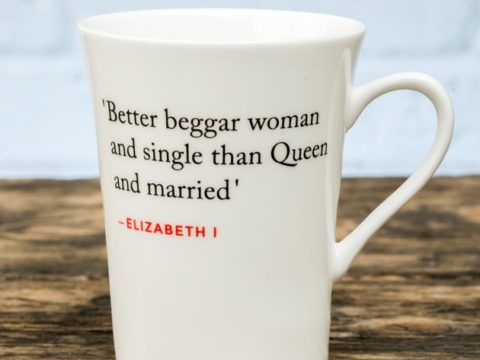Anne of Denmark: Life Story
Chapter 5 : Queen of Scots
Some of James’ subjects began to be restive with the prolonged absence of their monarch. In January one Patrick Galloway was sent as a messenger from the General Assembly of the Kirk. They were worried that in the King’s absence, the pro-Catholic nobles were plotting with Spain.
James was reluctant to fix a date for his return, only sending messages that he would return without warning – presumably to keep his Councillors on their toes. It was also reported in January that Anne was already pregnant, although by April the rumour seemed to be discredited – either she had never been pregnant, or she had an early miscarriage.
Anne opened formal correspondence with the Queen of England, who wrote a polite response in April, saying she hoped for nothing more than to be able to gratify any request Anne might have, and to hear that Anne and James had returned to Scotland, so that she could receive more frequent news of them.
The royal couple finally departed from Elsinore on Tuesday 21st April, 1590, arriving in Leith on 1st May. The following day, James issued a proclamation about the appropriate treatment of Danish subjects in Scotland. Referring to his visit to Denmark to fetch his ‘dearest spouse and queen’, he informed his subjects that the Danes had treated him extremely well, and shown him much courtesy, humanity and ‘heartliness’. His subjects were to treat the visiting Danes equally politely.
Anne was crowned as Queen of Scots on 17th May, 1590 in the first Protestant coronation of a Queen Consort in Scotland. The original plan had been for the ceremony to take place in St Giles’ Kirk, the primary church in Edinburgh and encompass Anne’s formal entry into the capital, but it was felt by the Protestant ministers that there might be pageants and entertainments that were not suited to the Sabbath, which was taken very seriously. Instead, the coronation took place at Holyrood Palace, with the welcome procession into the city taking place on the following Tuesday – a decision which offended the city burgesses.
In attendance were the Duke of Lennox, Lord John Hamilton, the Earl Marischall, the Earls of Mar, Montrose, Angus, Crawford, Ross, Atholl, Moray and Bothwell, as well as a host of lesser nobles and Danish guests. The Bishop of Orkney performed the ceremony. The ceremony was performed by the Presbyterian, Robert Bruce, who, under protest accepted the traditional rite of anointing with oil, rather than have the coronation performed by one of the remaining Scottish Bishops. The traditional rituals were carefully pointed out as being merely civil ceremonies and not having any of the connotations that they had once had as part of a Catholic ritual. Fifteen gentlemen were knighted, as part of the celebrations.
Anne, although she had been promised liberty to practise her Lutheran faith, was pressed by Bruce to ‘[confess] the faith and religion which we profess’ – the more radical Calvinist form of Protestantism. She was also to work against all ‘Popish superstition.’
Nor were Anne and James free of other niggles at their homecoming. Anne’s Danish commissioners believed that Linlithgow, Falkland and Dunfermline palaces, which had all been granted to her, were of insufficient value, and in poor condition. James, always generous, but perennially broke, assured the Danes that he would make up the value. They pressed for a settlement equivalent to that received by Margaret Tudor on her marriage to James IV. The grant of Dunfermline would lead to further complications, as it had been taken from the Earl of Huntly, following accusations of treason in 1588.
On 24th May, James attended St Giles Kirk for Sunday worship. Afterwards, he made an announcement, thanking the people for the prayers and fasting they had undertaken in his absence, for the expenditure they had incurred in greeting the new Queen and for their courteous treatment of the Danish visitors. In return, he would ensure government was properly reformed and enemies of the Kirk banished. To this end, a number of reforms were instigated in James’ household to reduce costs, and action was taken against the Earl of Huntly and others who had harboured Huntly’s uncle, a Jesuit.
Shortly afterwards, the Danish commissioners and guests left, and Anne was now on her own with her new husband and subjects. She and James spent much of their time together, when he was not working, often hunting – a sport they both enjoyed.
In June, the Earl of Worcester arrived from England, bearing letters and gifts from Elizabeth, as well as the announcement that James was to be admitted to the Order of the Garter, along with the French King. Worcester asked to see Anne to present the letters addressed directly to her, but James told him that Anne was ill with toothache. Worcester immediately leapt on this as indicating that she was pregnant – the low levels of calcium in diet in the past often led women to lose teeth in pregnancy.
The letter that was delivered from Elizabeth was in that queen’s usual flowery style. Anne however could match her in compliments. She thanked Elizabeth for the ‘rich and truly very royal gifts’ which she herself was ‘unable worthily to remunerate except by an affection and goodwill like unto your own….’. She wrote in French, and signed herself ‘Anna R’, Anna being the spelling of her name that she continued to use, although James called her ‘Annie’.
Anne of Denmark
Family Tree




